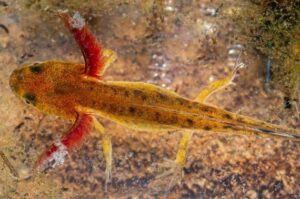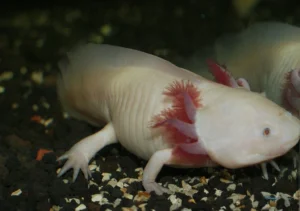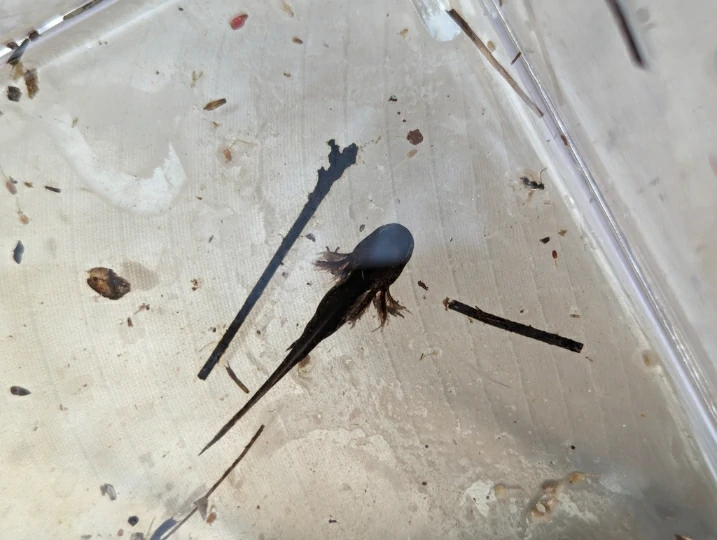If you’ve ever scooped up a young newt from a pond, you probably noticed the feathery gills sticking out from the sides of its head.
At that moment, you might have wondered, if it already breathes with gills, how does it survive on land later? Do newts actually grow lungs?
Yes, newts grow lungs as they develop. They start life breathing through gills, but as they go through metamorphosis, their gills shrink and lungs form inside, getting them ready for life on land.
This change is one of the most important steps in their survival.
Why Do Baby Newts Start With Gills?
When newts hatch from their jelly-covered eggs, they live completely underwater.
They need gills because water doesn’t have as much oxygen as air, and getting oxygen out of water takes special structures.
The gills look like delicate, frilly branches sticking out from the head. They wave gently as the larva moves, pulling oxygen straight from the water.

At this stage, lungs wouldn’t help much, gills are far more efficient.
So baby newts start their lives as underwater creatures, breathing exactly the way they need to for that environment.
When Do Lungs Start to Grow?
As the larva grows legs and gets ready to leave the pond, its body starts to change inside. The gills shrink slowly, and tiny lungs begin to form and expand. This is part of metamorphosis.
The change doesn’t happen overnight. For weeks, the newt uses a mix of gills, skin breathing, and the growing lungs.
This overlap makes sure there’s never a moment when it can’t breathe properly.
How Do Newts Use Their Lungs on Land?
When a young newt finally crawls out of the water as a juvenile, it relies mainly on lungs to breathe air.
The lungs are simple compared to ours, but strong enough to keep oxygen flowing when the animal is away from water.

Unlike mammals, newts don’t have a diaphragm to pull air in. Instead, they gulp air using throat movements, almost like swallowing breaths.
It looks different, but it works perfectly for their small bodies.
Do Adult Newts Still Use Their Lungs in Water?
Yes. Adult newts are amphibians, which means they can switch between land and water. When they’re in ponds, they still come up from time to time to gulp air.
You might see one rise slowly, poke its snout just above the surface, take a quick breath, then dive back down.
That’s their lungs at work. Even though they live in water, skin breathing alone isn’t enough for their energy needs.
Can Newts Breathe Through Their Skin Too?
Here’s where it gets even more interesting. Newts don’t just use lungs, they also absorb oxygen through their skin, especially when resting.
Their skin stays moist with a layer of mucus, which lets gases pass through. This means even if they stay underwater a long time, their skin helps them breathe
But when they’re more active or when oxygen levels in the water drop, lungs become very important.
So in a way, newts have two breathing systems working together.
Why Is Growing Lungs So Important?
Without lungs, newts would be stuck in water their whole lives. Lungs open up a whole new world. With them, newts can:
-
Leave the pond to hunt for worms, insects, and small prey on land.
-
Travel between ponds and streams during rainy nights.
-
Survive dry seasons by hiding in damp soil instead of being stuck in shrinking ponds.
Growing lungs is the step that makes the amphibian lifestyle possible.
Do All Newts Grow Lungs the Same Way?
Most species follow the same basic path: gills as larvae, then lungs as they transform. But there are exceptions.
Some salamanders, which are close relatives of newts, never grow lungs and keep their gills forever.

Others, like axolotls, stay in a larva-like state their whole lives unless something pushes them to change.
Newts are flexible, but in most cases, yes, they grow lungs because their adult life needs them.
What Happens if Newts Can’t Use Their Lungs Properly?
Sometimes in captivity, people notice newts floating awkwardly or struggling to dive. This can happen if the lungs are over-inflated, infected, or not working well.
Sick newts may spend more time at the surface, unable to balance.
In the wild, problems like this can be deadly. A newt that can’t surface and breathe risks drowning.
This shows just how important lungs are, not just for life on land, but also for survival in water.
How Do Newts Manage Breathing in Different Seasons?
In spring, when newts gather in ponds for breeding, they use both lungs and skin to stay active underwater.
In summer, when they spend more time on land, lungs are their main tool. They breathe like small lizards or frogs, gulping air into their bodies.
In winter, many newts hibernate underground or under mud.
Their metabolism slows, and they rely more on skin breathing while resting, but lungs still play a quiet role when they shift or move in their hiding spots.
Why Don’t Newts Keep Their Gills Forever?
This is a question many people ask. Gills work so well in water, so why bother with lungs at all? The answer is freedom.
If newts only had gills, they’d be stuck in ponds, completely tied to water. With lungs, they can explore forests, fields, and wetlands, finding food and shelter where fish or tadpoles could never go.
This flexibility is the secret to the success of amphibians: lungs give them a second home on land.
Conclusion
So, do newts grow lungs? Yes. They start life with gills in water, then slowly grow lungs during metamorphosis, giving them the power to live on both land and in ponds.
Alongside their skin breathing, lungs let them survive in changing environments and move freely between water and land.
It’s not just a body change, it’s a doorway to an entirely new way of living. The next time you see a newt rise and pause at the water’s surface, remember: that quiet gulp of air is one of the most important steps in its remarkable life story.
Hi, my name is Ezra Mushala, i have been interested animals all my life. I am the main author and editor here at snakeinformer.com.

